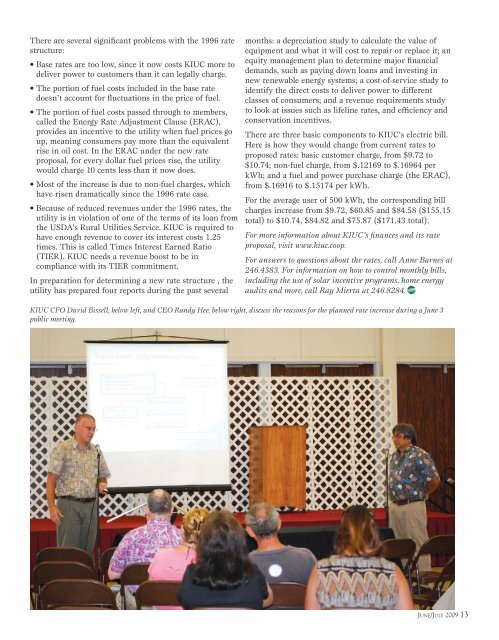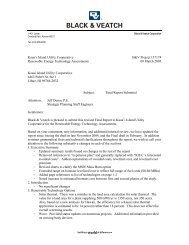KIUC's Rate Case - Kauai Island Utility Cooperative
KIUC's Rate Case - Kauai Island Utility Cooperative
KIUC's Rate Case - Kauai Island Utility Cooperative
You also want an ePaper? Increase the reach of your titles
YUMPU automatically turns print PDFs into web optimized ePapers that Google loves.
There are several significant problems with the 1996 rate<br />
structure:<br />
• Base rates are too low, since it now costs KIUC more to<br />
deliver power to customers than it can legally charge.<br />
• The portion of fuel costs included in the base rate<br />
doesn’t account for fluctuations in the price of fuel.<br />
• The portion of fuel costs passed through to members,<br />
called the Energy <strong>Rate</strong> Adjustment Clause (ERAC),<br />
provides an incentive to the utility when fuel prices go<br />
up, meaning consumers pay more than the equivalent<br />
rise in oil cost. In the ERAC under the new rate<br />
proposal, for every dollar fuel prices rise, the utility<br />
would charge 10 cents less than it now does.<br />
• Most of the increase is due to non-fuel charges, which<br />
have risen dramatically since the 1996 rate case.<br />
• Because of reduced revenues under the 1996 rates, the<br />
utility is in violation of one of the terms of its loan from<br />
the USDA’s Rural Utilities Service. KIUC is required to<br />
have enough revenue to cover its interest costs 1.25<br />
times. This is called Times Interest Earned Ratio<br />
(TIER). KIUC needs a revenue boost to be in<br />
compliance with its TIER commitment.<br />
In preparation for determining a new rate structure , the<br />
utility has prepared four reports during the past several<br />
months: a depreciation study to calculate the value of<br />
equipment and what it will cost to repair or replace it; an<br />
equity management plan to determine major financial<br />
demands, such as paying down loans and investing in<br />
new renewable energy systems; a cost-of-service study to<br />
identify the direct costs to deliver power to different<br />
classes of consumers; and a revenue requirements study<br />
to look at issues such as lifeline rates, and efficiency and<br />
conservation incentives.<br />
There are three basic components to KIUC’s electric bill.<br />
Here is how they would change from current rates to<br />
proposed rates: basic customer charge, from $9.72 to<br />
$10.74; non-fuel charge, from $.12169 to $.16964 per<br />
kWh; and a fuel and power purchase charge (the ERAC),<br />
from $.16916 to $.15174 per kWh.<br />
For the average user of 500 kWh, the corresponding bill<br />
charges increase from $9.72, $60.85 and $84.58 ($155.15<br />
total) to $10.74, $84.82 and $75.87 ($171.43 total).<br />
For more information about KIUC’s finances and its rate<br />
proposal, visit www.kiuc.coop.<br />
For answers to questions about the rates, call Anne Barnes at<br />
246.4383. For information on how to control monthly bills,<br />
including the use of solar incentive programs, home energy<br />
audits and more, call Ray Mierta at 246.8284.<br />
KIUC CFO David Bissell, below left, and CEO Randy Hee, below right, discuss the reasons for the planned rate increase during a June 3<br />
public meeting.<br />
JUNE/JULY 2009 13
















